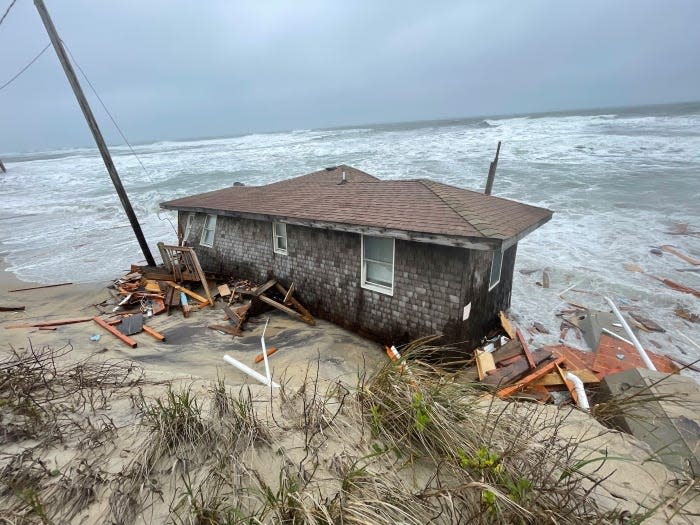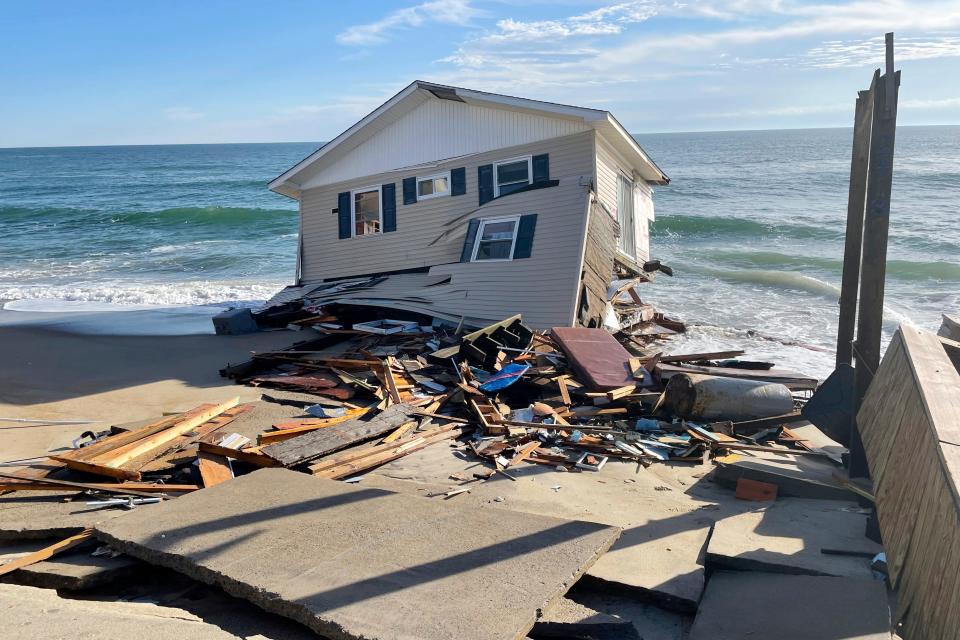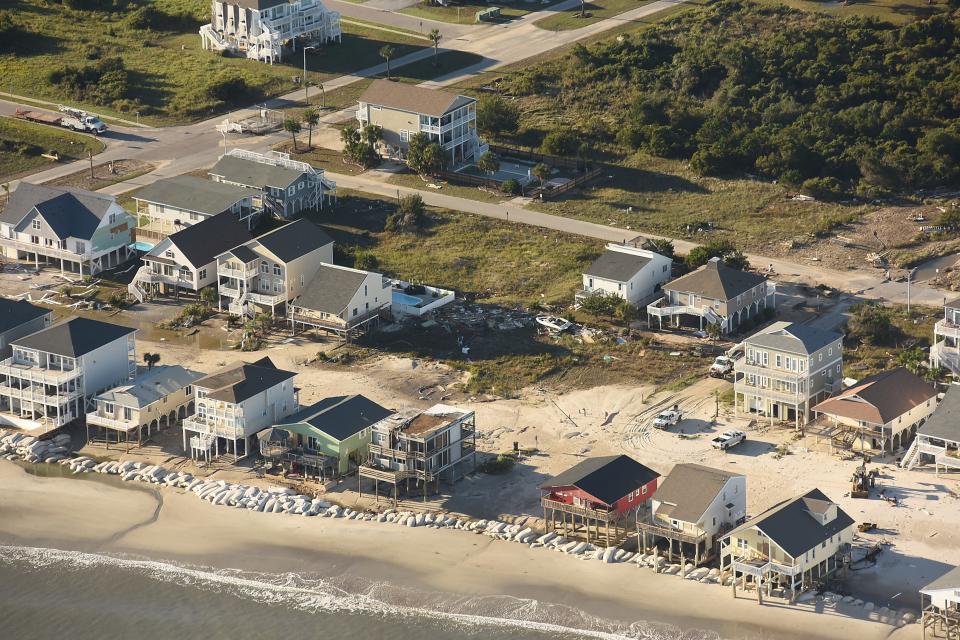Why did the National Park Service buy threatened oceanfront homes on the Outer Banks?
It's not a new story. Beachfront homes along the North Carolina coast about to fall into the Atlantic, and local officials and property owners looking for answers that won't leave them financially broke.
But two threatened oceanfront homes on the Outer Banks were recently purchased, and the buyer might surprise most people.
They weren't bought by speculators looking to make a quick buck, or folks hoping the beach in Rodanthe reverses its decades-long retreat and returns.
Instead, they were bought by the Cape Hatteras National Seashore using nonprofit conservation trust funds. But why would the federal government want to buy beachfront homes teetering on the edge? And could the approach used by the park service offer a way forward for other N.C. coastal communities and oceanfront property owners dealing with their own erosion woes?
Officials say what happened in Rodanthe should be seen as unique for a number of reasons. But that doesn't mean thinking outside-the-box isn't something other officials and locations should consider as funding for − and sand itself − for beach nourishment becomes harder to secure just as sea-level rise ramps up.
"It's another tool in the toolbox of creative solutions that we're going to have to start thinking about, because situations like this aren't going away anytime soon," said Alyson Flynn, a coastal advocate and environmental economist with the N.C. Coastal Federation.

A special situation
Rodanthe isn't a town itself, but an unincorporated village that's managed by the state and Dare County inland and by the national seashore along the ocean. That blend of jurisdictions, which can move monthly, weekly and even daily as the "wet beach" − which is public property − ebbs and flows with the tremendous erosion rates that section of the Outer Banks endures, can often lead to bureaucratic inertia and confusion over who is in charge.
But in this case, the involvement of the federal government opened up the involvement of a powerful, major player interested in not seeing another home come crashing down and potentially creating a miles-long debris field that could soil beaches well away from Rodanthe and prove dangerous for visitors, shorebirds and nesting sea turtles.
Since an oceanfront house in Rodanthe fell in February 2022, three others nearby have collapsed and numerous nearby structures along the eroded shoreline are also threatened. With Washington and Raleigh having made it clear that there would be no money coming anytime soon for a beach nourishment project and Dare County officials stating that the county's funding pool for beach-building work had all but run dry, many Rodanthe property owners were facing a tough future.
CHANGING LANDSCAPE On the Outer Banks, structures rise and fall as climate change looms
PHOTOS Images from the Outer Banks
So the park service decided to get creative and tap funds from the Land and Water Conservation Fund, a program established by Congress in 1964 to safeguard important cultural and natural areas and to expand recreational opportunities. It is funded by earnings on offshore oil and gas leasing, so it doesn't rely on taxpayer dollars.
According to Dare County tax records, the park service paid $471,000 for one of the homes, a six-bedroom house, and $260,000 for the other, a four-bedroom house. According to a web post, the park service said it paid "fair-market value" for the properties and hopes to start the process of removing them from the beach in the next few weeks. Park officials also said they are interested in expanding the program to include other nearby threatened structures.

Tough choices ahead
With willing sellers and a motivated governmental entity looking for a solution, the proverbial stars aligned to get the Rodanthe deal done.
But many other spots along North Carolina's coast that are facing similar situations of the encroaching ocean threatening valuable shorefront property.
Granted, the erosion at Rodanthe is among the highest on the U.S. East Coast, meaning the impacts from climate change and rising sea-levels rise is hitting the small community harder than faster than almost anywhere else. And the Outer Banks are among the most popular beach vacation destinations in the country, meaning any collapsed beachfront house or ocean debris field is bound to attract lots of curious eyeballs.
But just the general idea of retreat isn't often embraced by local officials, who face hurdles from unwilling sellers to a lack of money to fund buyouts to questionable political will to pursue pulling back − especially when it could mean abandoning some of a beach town's most valuable tax base.
Environmentalists and others, though, say retreat is coming. The only question is whether it will be managed, done in a controlled way, or unmanaged as historically has been the case in most areas.
RISING TIDES, CONCERNS What rising sea levels mean for where and how we live along the NC coast
Beach nourishment, long the favored option for most local officials to deal with a disappearing beach, also is becoming less feasible in many cases due to the rising costs and lack of interest from federal and state officials to fund sand-pumping projects that have to be repeated every few years to work. North Topsail Beach, already struggling to deal with chronic erosion woes on its north end near New River Inlet, abandoned plans to participate in a beach nourishment project with Surf City due to cost concerns, and a Dare County study determined that nourishing Rodanthe's beach − residents' favored response to the village's erosion problems − would cost as much as $40 million. Maintaining that beach over 30 years would cost more than $175 million, the report found.
"Nourishment is a Band-Aid for a gashing wound," Flynn said. "It's not really a long-term solution."
She said while some coastal communities, like Figure Eight Island in New Hanover County and Bald Head Island in Brunswick County, can afford to look into beach nourishment or engineering answers to the rising waters due to their homeowners' deep pockets, that isn't a viable option for most coastal communities. That's where a focus on adopting smarter statewide policies, such as dealing with exposed septic tanks or when to call for the removal of a threatened structure, makes sense. The state and national seashore set up a working group last year to look into the problem of threatened oceanfront structures.
ANOTHER ANSWER? Study says buyout of threatened Outer Banks homes would be cheaper than beach nourishment
Tackling those thorny questions and adopting rules that while unpopular reflect reality will help in the long term, "because we know the seas are going to continue to rise and erosion is only going to become more severe," Flynn said.
That includes looking into financing options that might not be the typical route used in the past, like the park service tapping the Land and Conservation Fund for home removal.
"Erosion isn’t going to wait for us to come up with the most creative solution," Flynn said. "It’s going to be difficult and there’s no one right answer, but we need to have these conversation now.”

Collapsing oceanfront homes
Since 2020, five oceanfront homes have collapsed in Rodanthe. According to the Cape Hatteras National Seashore, four out of the five house collapses occurred over a 13-month period of time, including two collapses on the same day. Debris from the collapses was spotted more than 15 miles from the collapse site.
May 29, 2020: An unoccupied house collapsed during the overnight hours at 23238 Sea Oats Drive, Rodanthe.
February 9, 2022: On a calm winter day, an unoccupied house collapsed at 24183 Ocean Drive, Rodanthe.
May 10, 2022: During a multi-day nor'easter, an unoccupied house collapsed at 24235 Ocean Drive, Rodanthe. The collapsed occurred during the early morning hours.
May 10, 2022: During a multi-day nor'easter, an unoccupied house collapsed at 24265 Ocean Drive, Rodanthe. The collapse occurred during the early afternoon hours.
March 13, 2023: During inclement weather, an unoccupied house collapsed at 23228 East Point Drive, Rodanthe.
Reporter Gareth McGrath can be reached at GMcGrath@Gannett.com or @GarethMcGrathSN on Twitter. This story was produced with financial support from 1Earth Fund and the Prentice Foundation. The USA TODAY Network maintains full editorial control of the work.
This article originally appeared on Wilmington StarNews: Threatened homes on the Outer Banks, NC, bought by US government

